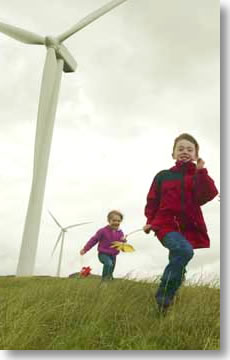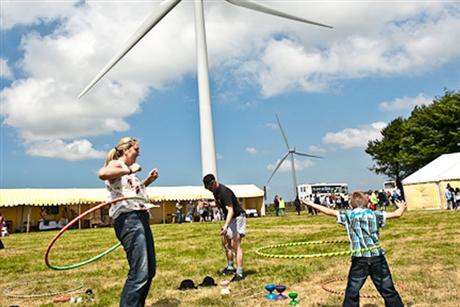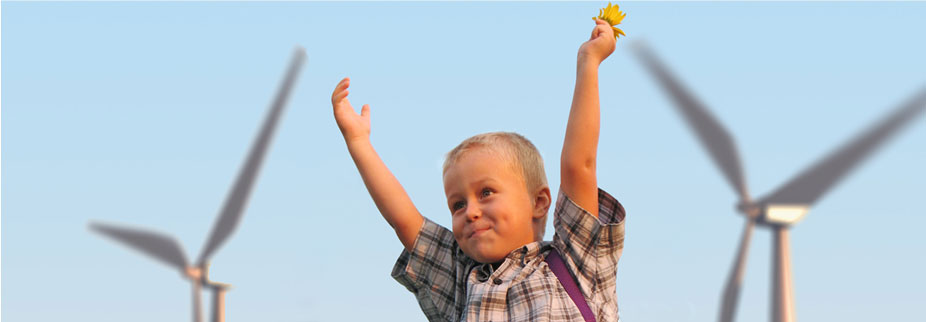11/23/10 Drinkin' with the PSC at the Wind Power Happy Hour AND Say it with Turbines: How a picture can wipe out 1000 facts AND Dispatch from Michigan: New Wind Circus, Same Wind Clowns AND On Electric Cars: Brother can you spare an extension cord?
SORRY WE MISSED THE PARTY: Drinking with the PSC
Note from the BPWI Research Nerd: For those of you who have been following the wind siting rules issue in our state, Deborah Erwin (pictured below) of the Wisconsin Public Service Commission will be a familiar name to you. The photo was taken at the August "WIND POWER HAPPY HOUR" event at the Capitol Brewery.
SOURCE: Breezesandbeverages.blogspot.com
Friday, September 3, 2010
Great Attendnce for the August Wind Power Happy Hour at Capital Brewery
 Photo: Deborah Erwin from the Wisconsin Public Service Commission and Mike Ross from American Superconductor at Capital Brewery in Middleton, Wisconsin.
Photo: Deborah Erwin from the Wisconsin Public Service Commission and Mike Ross from American Superconductor at Capital Brewery in Middleton, Wisconsin.
In what turned out to be one of our most well attended events of the year, more than 60 people attended the August Wind Power Happy Hour to sample some of Capital Brewery's finest offerings, sit in the Bier Garten on one of the nicest days of the summer, and to hear from a couple of great presenters.
Mike Ross, Sr. Engineer for American Superconductor in Middleton, Wisconsin was the company spotlight for this meeting. He provided an overview of three key aspects of AMSC's products: Windtec technology, superconducting cables, and the SeaTitan--a 10 MW wind turbine being developed for off shore purposes. Mike also shared that AMSC recently acquired an ownership stake in Blade Dynamics, a designer and manufacturer of advanced wind turbine blades based on proprietary materials and structural technologies.
Deborah Erwin is the Docket Manager for the Public Service Commission and the Wind Siting Council that has been developing rules for wind farms under 100 MW in Wisconsin. Its been a tough job, but she reported they are almost ready to be sent to the Legislature for approval. Click here to see a current copy of the proposed Wind Siting rules and the press release issued by the PSC on their completion of their efforts.
Special thanks to Capital Brewery for their hospitality, and for letting us use the Bier Stube for our event.
FIRST FEATURE:

THE ALLURE OF TECHNO-GLAMOR
Source: Wall Street Journal
November 20, 2010
By Virgina Postrel
[Please note: photos added by Better Plan]
When Robert J. Samuelson published a Newsweek column last month arguing that high-speed rail is "a perfect example of wasteful spending masquerading as a respectable social cause," he cited cost figures and potential ridership to demonstrate that even the rosiest scenarios wouldn't justify the investment.
He made a good, rational case—only to have it completely undermined by the evocative photograph the magazine chose to accompany the article.
The picture showed a sleek train bursting through blurred lines of track and scenery, the embodiment of elegant, effortless speed. It was the kind of image that creates longing, the kind of image a bunch of numbers cannot refute. It was beautiful, manipulative and deeply glamorous.
 The same is true of photos of wind turbines adorning ads for everything from Aveda's beauty products to MIT's Sloan School of Management. These graceful forms have succeeded the rocket ships and atomic symbols of the 1950s to become the new icons of the technological future. If the island of Wuhu, where games for the Wii console play out, can run on wind power, why can't the real world?
The same is true of photos of wind turbines adorning ads for everything from Aveda's beauty products to MIT's Sloan School of Management. These graceful forms have succeeded the rocket ships and atomic symbols of the 1950s to become the new icons of the technological future. If the island of Wuhu, where games for the Wii console play out, can run on wind power, why can't the real world?
Policy wonks assume the current rage for wind farms and high-speed rail has something to do with efficiently reducing carbon emissions. So they debate load mismatches and ridership figures. These are worthy discussions and address real questions.
But they miss the emotional point.
To their most ardent advocates, and increasingly to the public at large, these technologies aren't just about generating electricity or getting from one city to another. They are symbols of an ideal world, longing disguised as problem solving. You can't counter glamour with statistics.
 Glamour always contains an element of illusion. (The word originally meant a literal magic spell.) By obscuring some details and heightening others, it offers an escape from the compromises, flaws and distractions of real life. It shows no bills on the kitchen counter, no blisters under the high heels, no pimples on the movie star's face.
Glamour always contains an element of illusion. (The word originally meant a literal magic spell.) By obscuring some details and heightening others, it offers an escape from the compromises, flaws and distractions of real life. It shows no bills on the kitchen counter, no blisters under the high heels, no pimples on the movie star's face.
In those glamour shots, wind power seems clean, free and infinitely abundant. Turbines spin silently and sometimes appear barely taller than a child. The wind blows constantly and in exactly the right amount—never so much that it piles up unwanted power and never so little that it requires backup supply. The sky is unfailingly photogenic, a backdrop of either puffy clouds or a brilliant sunset; the landscape is both empty and beautiful; and there are no transmission lines anywhere.

The image of a speeding train, meanwhile, invites you to imagine taking it when and where you want, with no waiting, no crowds and no expensive tickets. Like the turbines, high-speed trains exemplify autonomy and grace, sliding along effortlessly, with no visible source of fuel. To a stressed-out public, they promise an escape from traffic jams—and, at least until the first terrorism scare, from the hassles, intrusion and delays of airport security.
For all its deceptiveness and mystery, glamour reveals emotional truths. What today's green techno-glamour demonstrates, first and foremost, is that its audience has no inclination to give up the benefits of modernity and return to the pre-industrial state idealized by radical greens. Neither the Unabomber nor Henry David Thoreau would go for wind farms and high-speed rail. To the contrary, these iconic new machines cater to what Al Gore denounced in "Earth in the Balance" as "the public's desire to believe that sacrifice, struggle and a wrenching transformation of society will not be necessary." They promise that a green future will be just as pleasant as today, only cleaner and more elegant.
For at least some technophiles, in fact, the trains and windmills are goods in and of themselves, with climate change providing a reason to force the development and adoption of cool new machines that wouldn't otherwise catch on. These technologies also restore the idea of progress as big, visible engineering projects—an alternative to the decentralized, hidden ingenuity of computer code.
They evoke the old World's Fair sense of hope and wonder, a feeling President Barack Obama draws on when he endorses high-speed rail subsidies as "building for the future." They are the latest incarnation of flying cars and electricity too cheap to meter.
The problems come, of course, in the things glamour omits, including all those annoyingly practical concerns the policy wonks insist on debating. Neither trains nor wind farms are as effortlessly liberating as their photos suggest. Neither really offers an escape from the world of compromises and constraints. The same is true, of course, of evening gowns, dream kitchens and tropical vacations. But at least the people who enjoy that sort of glamour pay their own way.
—Virginia Postrel is the author of "The Future and Its Enemies" and "The Substance of Style." She is writing a book on glamour.
SECOND FEATURE:
TURBINES IN GARDEN'S FUTURE
SOURCE: The Daily Press, www.dailypress.net
November 22 2010
By Ashley Hoholik
What does the contract say about the wind developer's rights over your land?
“…[Wind developer] shall have a non-exclusive easement over and across said property for audio, visual, view, light, noise, vibration, air turbulence, wake, electromagnetic, electrical, and radio frequency interference, and any other effects attributable to [wind developer's] operations.”
The lease further stipulates: “[Property owner] waives any claim with regard to any such interference or effects.”
GARDEN – A landscape dotted with wind turbines is in the Garden Peninsula’s future, thanks to a downstate sustainable energy firm. Heritage Sustainable Energy, of Traverse City, Mich., has already signed leases with a number of area residents, but not everyone is welcoming the company.
After nearly two years of various wind studies conducted in the Garden area, some by Heritage, few residents were surprised when a company began to seriously pursue unused parcels of land.
Heritage, which is best known for its nearly 2,000-acre Stoney Corners Wind Farm Project near Cadillac, Mich., plans to site leased areas and assess the land’s potential in housing one of their nearly 400-foot wind turbines.
According to Heritage Project Manager Rick Wilson, the company is excited about the Garden Township Wind Energy Project and has already leased approximately 10,000 acres throughout the Garden Peninsula, including Garden and Fairbanks Township.
“The size of this wind project is moderate; about 13 wind turbines will be placed on agricultural land between south Garden to north of Garden,” Wilson said.
“We’ve been doing energy analysis in the area for about three years and have three meteorological towers already out there.”
Wilson said the turbines will be used to produce energy that will then be sold into the transmission grid and passed on to larger Michigan utility companies.
“We’ve done the preliminary studies, done the pre-planning work, and now we are in the pre-development stages,” he explained. “We’re working toward developing this project and are hoping to begin installation of the wind turbines by the end of 2011 or early 2012.”
According to a Heritage 10-year lease provided to a Garden resident, anyone leasing their land to Heritage will be paid $15 per net surface acre. If the company decides to actually build on the leased land, a one-time $10,000 fee will be paid to the lessee. The lease also notes that Heritage has the option to continue the lease beyond the 10-year period by paying an extension payment of $30 per net surface acre. For this reason, the lease is “considered to be continuous.”
While some residents were quick to jump on board with Heritage’s project, whether it was for the financial perks, to support alternative energy or a combination of the two, others are not as willing.
Cliff and Rosemary Stollings of Garden were approached by Heritage, but decided against leasing their land. Their concerns are rooted in the fact that, currently, Delta County has no zoning ordinance for wind energy. This would give too much leeway to Heritage, said Cliff, and offers no governance on the distance a wind turbine needs to be away from a residence.
The Heritage lease stipulates that a wind turbine will have to be at least 400 feet away from a residence. Conversely, the Stollings claim that, in researching wind energy, it is now generally recommended that wind turbines be at least a mile to a mile and a half away from a residence.
While there is conflicting research regarding a wind turbine’s proximity and subsequent impact on wildlife and human health, the Stollings’ factored the potential negative impact in their decision.
A portion of the lease addresses some of these possible impacts, but not in the way that the Stollings would have liked:
“…Lessee shall have a non-exclusive easement over and across said property for audio, visual, view, light, noise, vibration, air turbulence, wake, electromagnetic, electrical, and radio frequency interference, and any any other effects attributable to Lessee’s operations.” The lease further stipulates: “Lessor waives any claim with regard to any such interference or effects.”
Garden Township Supervisor Morgan Tatrow said that Heritage has been visiting the area frequently, working with the township and attending a county joint governmental meeting, various Garden township meetings, and even school board meetings.
“Heritage has already obtained lease permits from private property owners, and their plans right now are to obtain the permits for access roads leading to their wind turbine locations,” explained Tatrow. “We, the township, are talking with our legal people because there are currently no ordinances regarding wind towers.” In the meantime, Heritage will continue work on the project as residents from both sides voice their support or concern.
“It’s an excellent project and an economic opportunity for Delta County and Garden Township,” said Wilson. “It is going to mean around $5 million worth of investment in the local community during the construction process and the estimated personal property tax revenue is between $30,000 to $40,000 per turbine, per year.”
THIRD FEATURE
On Electric Cars---
Adding an electric vehicle or two to a neighborhood can be like adding another house, and it can stress the equipment that services those houses. "We're talking about doubling the load of a conventional home," says Karl Rabago, who leads Austin Energy's electric vehicle-readiness program. "It's big."
Opportunity has power industry scrambling
Benefits: Big cuts in fuel costs, greenhouse gas emissions
SOURCE: Portland Press Herald
November 22, 2010
By JONATHAN FAHEY The Associated Press
HOME CHARGE MAY BE A JOLT
NEW YORK - Getting your home ready to charge an electric car will require little time or money -- or a couple months and thousands of dollars.
It depends on what kind of electric car you buy, the wiring in your home and how quickly you want to juice your ride.
Electric cars are powered by batteries that are charged by plugging them into a standard wall socket or a more powerful charging station.
The charging station will cut your charging time roughly in half, and reduce the chance you'll trip a circuit. But it will likely cost $2,000 or more.
The price will rise if you need a new electrical panel, which could add another $2,000.
The main thing to consider is how you are going to use your electric car.
If your commute is short, or there's a charging station near your office, you might not need much of a charge at home. You can get away with topping off your battery overnight.
A standard 120-volt wall socket will give a car about five miles of driving for every hour of charging. That means if you had a 40 mile round-trip commute you'd be able to charge in 8 hours.
If you deplete your battery most days, a charging station connected to a 240-volt socket, like ones used for most electric dryers, could be worthwhile.
-- The Associated Press
The first mass-market electric cars go on sale next month, and the nation's electric utilities couldn't be more thrilled -- or worried.
Plugged into a socket, an electric car can draw as much power as a small house.
The surge in demand could knock out power to a home, or even a neighborhood. That has utilities in parts of California, Texas and North Carolina scrambling to upgrade transformers and other equipment in neighborhoods where the Nissan Leaf and Chevrolet Volt are expected to be in high demand.
Not since air conditioning spread across the country in the 1950s and 1960s has the power industry faced such a growth opportunity.
Last year, Americans spent $325 billion on gasoline, and utilities would love even a small piece of that market.
The main obstacles to wide-scale use of electric cars are high cost and limited range, at least until a network of charging stations is built. But utility executives fret that difficulties keeping the lights on for the first crop of buyers -- and their neighbors -- could slow the growth of this new niche.
"You never get a second chance to make a first impression," says Mike Rowand, who is in charge of electric vehicle planning at Duke Energy.
Auto executives say it's inevitable that utilities will experience some difficulties early on. "We are all going to be a lot smarter two years from now," says Mark Perry, director of product planning for Nissan North America.
Electric cars run on big batteries that are charged by plugging into a standard wall socket or a more powerful charging station.
A combined 30,000 Nissan Leafs and Chevrolet Volts are expected to be sold over the next year. Over the next two years, Ford, Toyota and every other major automaker also plan to offer electric cars.
Governments are promoting the technology as a way to reduce dependence on foreign oil, cut greenhouse gas emissions and improve air quality.
Congress is offering electric car buyers a $7,500 tax credit and some states and cities provide additional subsidies that can total $8,000. The Leaf sells for $33,000, the Volt for $41,000.
Electric cars produce no emissions, but the electricity they are charged with is made mostly from fossil fuels like coal and natural gas, which do. Still, electric cars produce two-thirds fewer greenhouse gas emissions, on average, than a similarly sized car that runs on gasoline, according to the Natural Resources Defense Council.
Driving 10,000 miles on electricity will use about 2,500 kilowatt-hours, or 20 percent more than the average annual consumption of U.S. homes. At an average utility rate of 11 cents per kilowatt-hour, that's $275 for a year of fuel, equivalent to about 70 cents per gallon of gasoline.
"Electric vehicles have the potential to completely transform our business," says David Owens, executive vice president of the Edison Electric Institute, a trade group.
Nationwide, utilities have enough power plants and equipment to power hundreds of thousands of electric cars. Problems could crop up long before that many are sold, though, because of a phenomenon carmakers and utilities call "clustering."
Electric vehicle clusters are expected in neighborhoods where:
• Generous subsidies are offered by states and localities.
• Weather is mild, because batteries tend to perform better in warmer climates.
• High-income and environmentally conscious commuters live.
So while states like North Dakota and Montana may see very few electric cars, California cities like Santa Monica, Santa Barbara and Monrovia could see several vehicles on a block.
SoCal Edison expects to be charging 100,000 cars by 2015. California has set a goal of 1 million electric vehicles by 2020.
Progress Energy is expecting electric car clusters to form in Raleigh, Cary and Asheville, N.C. and around Orlando and Tampa, Fla. Duke Energy is expecting the same in Charlotte and Indianapolis.
Adding an electric vehicle or two to a neighborhood can be like adding another house, and it can stress the equipment that services those houses. "We're talking about doubling the load of a conventional home," says Karl Rabago, who leads Austin Energy's electric vehicle-readiness program. "It's big."
